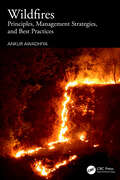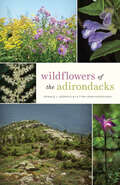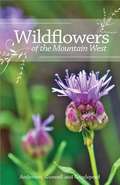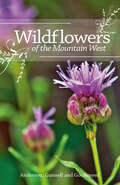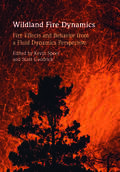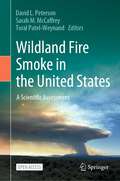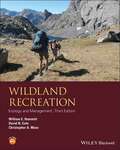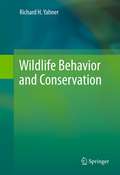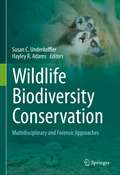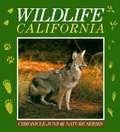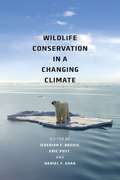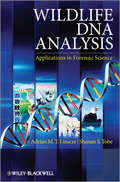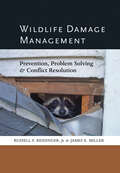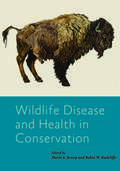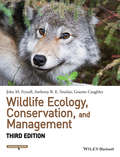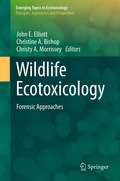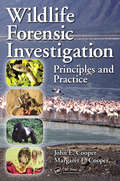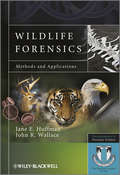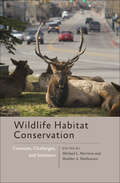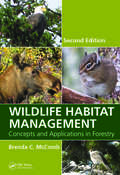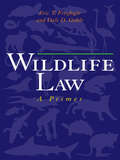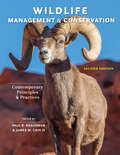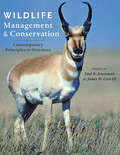- Table View
- List View
Wildfires: Principles, Management Strategies, and Best Practices
by Ankur AwadhiyaWildfires pose a persistent global challenge, affecting ecosystems, human societies, and the climate. This comprehensive volume, Wildfires: Principles, Management Strategies, and Best Practices, authored by Dr. Ankur Awadhiya, provides an authoritative exploration of the multifaceted nature of wildfires. Drawing from the author’s extensive experience as a forest officer and researcher, the book offers in-depth insights into the science of wildfires, their causes and effects, and the latest advancements in wildfire management. What distinguishes this book is its seamless integration of scientific principles, traditional knowledge, and cutting-edge technology, rendering it an indispensable resource for addressing wildfires in the context of climate change.Key Features- Extensive analysis of wildfire principles, encompassing their various types, underlying causes, and global distribution patterns.- Comprehensive coverage of the multifaceted effects of wildfires on ecosystems, human health, and climate change.- In-depth examination of strategies for wildfire prevention, detection, suppression, and post-fire restoration efforts.- Insights into advanced technologies such as satellite monitoring, LiDAR, Geographic Information Systems (GIS), unmanned aerial vehicles (drones), and artificial intelligence (AI) in wildfire management.- Real-world case studies from around the world, including the Yellowstone National Park wildfire and the Bandhavgarh Tiger Reserve wildfire, provide valuable empirical evidence of wildfire management.- Practical guidelines for integrating traditional fire management practices with contemporary techniques to enhance wildfire management effectiveness.This comprehensive resource is meticulously crafted to provide a holistic understanding of wildfire dynamics and management, catering to researchers, environmental scientists, policymakers, and field practitioners. It also serves as a valuable reference for students and educators in forestry, ecology, and environmental sciences. Equipped with rigorous analysis and actionable insights, Wildfires stands as the definitive guide to mitigating the formidable environmental challenges posed by wildfires.
Wildflowers of the Adirondacks
by Lytton John Musselman Donald J. LeopoldThe definitive field guide to the magnificent wildflowers of the Adirondacks.Covering more than six million acres of protected wilderness, the Adirondacks, with their landscape of high peaks, verdant wetlands, majestic trees, and lush carpets of flowers, is a pristine paradise for nature lovers. The only available identification guide to the Adirondack region's wildflowers, this comprehensive resource is packed with more than 300 gorgeous color images, one to represent almost every flower commonly found in this huge range. Revealing the stunning diversity of Adirondack wildflowers, from goldenrod and marsh blue violet to cattails and hellebore, the book includes • detailed botanical species accounts, arranged by flower color• images of each flower that highlight key features for easy ID• information about each species' natural history• descriptions of the region's upland, wetland, and aquatic habitats• a special section on the nearly 40 terrestrial orchid species found in the AdirondacksWritten by Donald J. Leopold and Lytton John Musselman, skilled botanists and the foremost authorities on these plants, this superior quality guide will appeal to residents of and visitors to the Adirondacks and northeastern mountains, including wildlife professionals, citizen scientists, backpackers, campers, photographers, bird watchers, artists, and wild food foragers.
Wildflowers of the Mountain West
by Richard M. Anderson Jerry L. Goodspeed Jay Dee GunnellMany recreational hikers have stopped along the trail to admire a wildflower only to wonder what, exactly, they are looking at. Wildflowers of the Mountain West is a useful field guide that makes flower identification easy for the general outdoor enthusiast.Many available plant guides are too technical or cumbersome for non-specialists to embrace. Covering New Mexico, Colorado, Wyoming, Idaho, Utah, Nevada and Oregon, this book is perfect for the enthusiasts who has little botanical knowledge but would like to know more about the wildflowers they are seeing. Organized by flower color for easy reference, plant records include the common and scientific names, a description of typical characteristics, habitat information and distribution maps, look-alike species, color photographs, and informative commentary. In addition, the book provides a useful introduction to the Mountain West region, along with line drawings to illustrate basic flower parts, shapes, and arrangements; a glossary of common botanical terms; a quick search key; and an index.The book is spiral-bound, making it easy to bring along while hiking, backpacking, or biking, and stunning full color photographs make visual confirmation of flower type simple and straightforward.
Wildflowers of the Mountain West
by Richard M. Anderson Jerry L. Goodspeed Jay Dee GunnellMany recreational hikers have stopped along the trail to admire a wildflower only to wonder what, exactly, they are looking at. Wildflowers of the Mountain West is a useful field guide that makes flower identification easy for the general outdoor enthusiast. Many available plant guides are too technical or cumbersome for non-specialists to embrace. Covering New Mexico, Colorado, Wyoming, Idaho, Utah, Nevada and Oregon, this book is perfect for the enthusiasts who has little botanical knowledge but would like to know more about the wildflowers they are seeing. Organized by flower color for easy reference, plant records include the common and scientific names, a description of typical characteristics, habitat information and distribution maps, look-alike species, color photographs, and informative commentary. In addition, the book provides a useful introduction to the Mountain West region, along with line drawings to illustrate basic flower parts, shapes, and arrangements; a glossary of common botanical terms; a quick search key; and an index. The book is spiral-bound, making it easy to bring along while hiking, backpacking, or biking, and stunning full color photographs make visual confirmation of flower type simple and straightforward.
Wildhood: The Astounding Connections between Human and Animal Adolescents
by Kathryn Bowers Dr. Barbara Natterson-HorowitzPublishers Weekly Most Anticipated Books of Fall 2019 A New York Times Editor&’s Pick People Best Books Fall 2019 Chicago Tribune 28 Books You Need to Read Now Booklist&’s Top Ten Sci-Tech Books of 2019 &“It blew my mind to discover that teenage animals and teenage humans are so similar. Both are naive risk-takers. I loved this book!&” —Temple Grandin, author of Animals Make Us Human and Animals in Translation A revelatory investigation of human and animal adolescence and young adulthood from the New York Times bestselling authors of Zoobiquity.With Wildhood, Harvard evolutionary biologist Barbara Natterson-Horowitz and award-winning science writer Kathryn Bowers have created an entirely new way of thinking about the crucial, vulnerable, and exhilarating phase of life between childhood and adulthood across the animal kingdom. In their critically acclaimed bestseller, Zoobiquity, the authors revealed the essential connection between human and animal health. In Wildhood, they turn the same eye-opening, species-spanning lens to adolescent young adult life. Traveling around the world and drawing from their latest research, they find that the same four universal challenges are faced by every adolescent human and animal on earth: how to be safe, how to navigate hierarchy; how to court potential mates; and how to feed oneself. Safety. Status. Sex. Self-reliance. How human and animal adolescents and young adults confront the challenges of wildhood shapes their adult destinies. Natterson-Horowitz and Bowers illuminate these core challenges through the lives of four animals in the wild: Ursula, a young king penguin; Shrink, a charismatic hyena; Salt, a matriarchal humpback whale; and Slavc, a roaming European wolf. Through their riveting stories—and those of countless others, from adventurous eagles and rambunctious high schooler to inexperienced orcas and naive young soldiers—readers get a vivid and game-changing portrait of adolescent young adults as a horizontal tribe, sharing behaviors and challenges, setbacks and triumphs. Upending our understanding of everything from risk-taking and anxiety to the origins of privilege and the nature of sexual coercion and consent, Wildhood is a profound and necessary guide to the perilous, thrilling, and universal journey to adulthood on planet earth.
Wildland Fire Dynamics: Fire Effects and Behavior from a Fluid Dynamics Perspective
by Kevin Speer Scott GoodrickWildland fires are among the most complicated environmental phenomena to model. Fire behavior models are commonly used to predict the direction and rate of spread of wildland fires based on fire history, fuel, and environmental conditions; however, more sophisticated computational fluid dynamic models are now being developed. This quantitative analysis of fire as a fluid dynamic phenomenon embedded in a highly turbulent flow is beginning to reveal the combined interactions of the vegetative structure, combustion-driven convective effects, and atmospheric boundary layer processes. This book provides an overview of the developments in modeling wildland fire dynamics and the key dynamical processes involved. Mathematical and dynamical principles are presented, and the complex phenomena that arise in wildland fire are discussed. Providing a state-of-the-art survey, it is a useful reference for scientists, researchers, and graduate students interested in wildland fire behavior from a broad range of fields.
Wildland Fire Smoke in the United States: A Scientific Assessment
by Toral Patel-Weynand David L. Peterson Sarah M. McCaffreyThis open access book synthesizes current information on wildland fire smoke in the United States, providing a scientific foundation for addressing the production of smoke from wildland fires. This will be increasingly critical as smoke exposure and degraded air quality are expected to increase in extent and severity in a warmer climate. Accurate smoke information is a foundation for helping individuals and communities to effectively mitigate potential smoke impacts from wildfires and prescribed fires. The book documents our current understanding of smoke science for (1) primary physical, chemical, and biological issues related to wildfire and prescribed fire, (2) key social issues, including human health and economic impacts, and (3) current and anticipated management and regulatory issues. Each chapter provides a summary of priorities for future research that provide a roadmap for developing scientific information that can improve smoke and fire management over the next decade.
Wildland Recreation
by William E. Hammitt David N. Cole Christopher A. MonzThe authoritative guide to understanding and managing the ecological impacts of recreational activities in wildlands This third edition provides an updated and thorough examination of the ecological impacts of recreational use on wildlands and the best management practices to employ in places where recreation and preservation of natural conditions are both important - and often conflicting - objectives. Covering the latest research, this edition provides detailed information about the environmental changes that result from recreational use. It describes spatial patterns of impact and trends over time, then explores the factors that determine magnitude of impact, including amount of use, type and behavior of use, and environmental durability. Numerous examples, drawn from parks and recreation areas around the world, give readers insight into why certain areas are more heavily damaged than others, and demonstrate the techniques available to mitigate damage. The book incorporates both the first-hand experience of the authors and an exhaustive review of the world's literature on the subject. Boxes provide quick access to important material, and further resources are referenced in an extensive bibliography. Essential reading for all park and protected area management professionals, this book is also a useful textbook for upper division undergraduate and graduate students on recreation ecology and recreation management courses.
Wildlife Behavior and Conservation
by Richard H. YahnerBegins with in-depth coverage of wildlife behavior concepts as they relate to conservation problems. Topics will focus principally on discussion, critique, and development of behavioral concepts, with particular attention given to published studies on various topics in wildlife behavioral concepts as related to conservation and natural history. He will include an extensive list of references.
Wildlife Biodiversity Conservation: Multidisciplinary and Forensic Approaches
by Susan C. Underkoffler Hayley R. AdamsThis book addresses the multidisciplinary challenges in biodiversity conservation with a focus on wildlife crime and how forensic tools can be applied to protect species and preserve ecosystems. Illustrated by numerous case studies covering different geographical regions and species the book introduces to the fundamentals of biodiversity conflicts, outlines the unique challenges of wildlife crime scenes and reviews latest techniques in environmental forensics, such as DNA metagenomics. In addition, the volume explores the socio-economic perspective of biodiversity protection and provides an overview of national and international conservation laws. The field of conservation medicine stresses the importance of recognizing that human health, animal health, and ecosystem health are inextricably interdependent and the book serves as important contribution towards achieving the UN Sustainable Developmental Goals, in particular SDG 15, Life on Land. The book addresses graduate students, scientists and veterinary professionals working in wildlife research and conservation biology.
Wildlife California
by Jill BrubakerThe book is a nature guide focusing on the mammals, reptiles, and birds that are found in the wilderness areas of California.
Wildlife Conservation in a Changing Climate
by Jedediah F. Brodie, Eric Post, and Daniel F. DoakHuman-induced climate change is emerging as one of the gravest threats to biodiversity in history, and while a vast amount of literature on the ecological impact of climate change exists, very little has been dedicated to the management of wildlife populations and communities in the wake of unprecedented habitat changes. Wildlife Conservation in a Changing Climate is an essential resource, bringing together leaders in the fields of climate change ecology, wildlife population dynamics, and environmental policy to examine the impacts of climate change on populations of terrestrial vertebrates. Chapters assess the details of climate change ecology, including demographic implications for individual populations, evolutionary responses, impacts on movement patterns, alterations of species interactions, and predicting impacts across regions. The contributors also present a number of strategies by which conservationists and wildlife managers can counter or mitigate the impacts of climate change as well as increase the resilience of wildlife populations to such changes. A seminal contribution to the fields of ecology and conservation biology, Wildlife Conservation in a Changing Climate will serve as the spark that ignites a new direction of discussions about and action on the ecology and conservation of wildlife in a changing climate.
Wildlife DNA Analysis
by Shanan Tobe Adrian LinacreClearly structured throughout, the introduction highlights the different types of crime where these techniques are regularly used. This chapter includes a discussion as to who performs forensic wildlife examinations, the standardisation and validation of methods, and the role of the expert witness in this type of alleged crime. This is followed by a detailed section on the science behind DNA typing including the problems in isolating DNA from trace material and subsequent genetic analysis are also covered. The book then undertakes a comprehensive review of species testing using DNA, including a step-by-step guide to sequence comparisons. A comparison of the different markers used in species testing highlights the criteria for a genetic marker. A full set of case histories illustrates the use of the different markers used. The book details the use of genetic markers to link two or more hairs/feather/leaves/needles to the same individual organism and the software used in population assignment. The problems and possibilities in isolating markers, along with the construction of allele databases are discussed in this chapter. The book concludes with evaluation and reporting of genetic evidence in wildlife forensic science illustrated by examples of witness statements.
Wildlife Damage Management: Prevention, Problem Solving, and Conflict Resolution
by James E. Miller Russell F. Reidinger Jr.A complete guide to preventing and resolving problems associated with wildlife-human interactions.Whether you are a student in a wildlife degree program or a professional wildlife biologist, you will find all the up-to-date information on wildlife damage in the pages of this clear, comprehensive text. Wildlife Damage Management covers every imaginable topic including:• pertinent biological and ecological concepts• individual-, population-, and ecosystem-level effects• survey techniques• management methods• human dimensions• economic issues• legal and political aspects• damage management strategiesAuthors Russell F. Reidinger, Jr., and James E. Miller explain the evolution of wildlife damage management, differentiate facts from myths, and detail the principles and techniques a professional biologist needs to know. The book discusses native as well as exotic invasive species, zoonotic diseases, hazards to endangered or threatened fauna and flora, and damage to crops, livestock, and property. Reidinger and Miller argue that, in recent years, the rate of undesirable human-wildlife interactions has risen in many areas, owing in part to the expansion of residences into places formerly wild or agricultural, making wildlife damage management even more relevant.From suburban deer eating gardens and shrubs, to mountain lions threatening pets and people, to accidentally introduced species outcompeting native species, Reidinger and Miller show how proper management can reduce wildlife damage to an acceptable, cost-effective level. An extensive section on available resources, a glossary that explains terms and concepts, and detailed figures will aid both students and seasoned professionals. Instructors will find this text arranged perfectly for a semester-long course. The end-of-chapter questions will allow students to ponder the ways wildlife damage management concepts can be put into practice. For those already working in the field—biologists and managers with federal, state, or international agencies—Wildlife Damage Management will serve as an ideal reference book. Destined to set the tone of wildlife damage conversations for the next decade and beyond, Reidinger and Miller belongs on the shelf of all wildlife professionals.
Wildlife Disease and Health in Conservation (Wildlife Management And Conservation Ser.)
by David A. Jessup and Robin W. RadcliffeWildlife Ecology And Management
by Eric G. Bolen William Laughlin RobinsonThis exceptionally comprehensive, single-source introduction to the art, science, theories, practices, and issues of wildlife management is ideal for the novice in the subject. Features full-chapters on predators, urban wildlife, policy, water, soil, diseases, conservation biology. New, up-to-date issues covered include the removal of dams, global warming, emerging diseases among elk and deer, adaptive harvest management, animal rights groups, women hunters, population data, migratory animals and more. For anyone interested in an exceptionally comprehensive introduction to wildlife management and conservation.
Wildlife Ecology, Conservation, and Management (Wiley Desktop Editions Ser.)
by Graeme Caughley John M. Fryxell Anthony R. SinclairTo understand modern principles of sustainable management and the conservation of wildlife species requires intimate knowledge about demography, animal behavior, and ecosystem dynamics. With emphasis on practical application and quantitative skill development, this book weaves together these disparate elements in a single coherent textbook for senior undergraduate and graduate students. It reviews analytical techniques, explaining the mathematical and statistical principles behind them, and shows how these can be used to formulate realistic objectives within an ecological framework. This third edition is comprehensive and up-to-date, and includes: Brand new chapters that disseminate rapidly developing topics in the field: habitat use and selection; habitat fragmentation, movement, and corridors; population viability. analysis, the consequences of climate change; and evolutionary responses to disturbance A thorough updating of all chapters to present important areas of wildlife research and management with recent developments and examples. A new online study aid – a wide variety of downloadable computer programs in the freeware packages R and Mathcad, available through a companion website. Worked examples enable readers to practice calculations explained in the text and to develop a solid understanding of key statistical procedures and population models commonly used in wildlife ecology and management. The first half of the book provides a solid background in key ecological concepts. The second half uses these concepts to develop a deeper understanding of the principles underlying wildlife management and conservation. Global examples of real-life management situations provide a broad perspective on the international problems of conservation, and detailed case histories demonstrate concepts and quantitative analyses. This third edition is also valuable to professional wildlife managers, park rangers, biological resource managers, and those working in ecotourism.
Wildlife Ecotoxicology
by Christine A. Bishop John E. Elliott Christy MorrisseyMany books have now been published in the broad field of environmental toxicology. However, to date, none of have presented the often fascinating stories of the wildlife science, and the steps along the way from discovery of problems caused by environmental pollutants to the regulatory and non-regulatory efforts to address the problems. This book provides case by case examinations of how toxic chemical effects on wildlife have brought about policy and regulatory decisions, and positive changes in environmental conditions. Wild animal stories, whether they are about the disappearance of charismatic top predators, or of grossly deformed embryos or frogs, provide powerful symbols that can and have captured the public's imagination and have resulted in increased awareness by decision makers. It is the intent of this book to present factual and balanced overviews and summaries of the science and the subsequent regulatory processes that followed to effect change (or not). We cover a variety of chemicals and topics beginning with an update of the classic California coastal DDT story of eggshell thinning and avian reproduction to more recent cases, such as the veterinarian pharmaceutical that has brought three species of Asian vultures to the brink of extinction. Researchers, regulators, educators, NGOs and the general public will find valuable insights into the processes and mechanisms involved both in environmental scientific investigation and in efforts to effect positive change.
Wildlife Forensic Investigation: Principles and Practice
by John E. Cooper Margaret E. CooperProviding an in-depth introduction to the rapidly evolving field of wildlife forensics, this volume also chronicles aspects of the history of management, conservation, and environmental protection, with an emphasis on their global importance in the twenty-first century. The book examines the crucial role of wildlife forensic investigation with regard to live animals, dead animals, and samples and covers national, regional, and international legislation. The book discusses animal welfare as well as the damage that can be inflicted on humans and property by wildlife. The text is enhanced by case studies from experts who describe some of their own work.
Wildlife Forensics
by John R. Wallace Jane E. HuffmanWildlife Forensics: Methods and Applications provides an accessible and practical approach to the key areas involved in this developing subject. The book contains case studies throughout the text that take the reader from the field, to the lab analysis to the court room, giving a complete insight into the path of forensic evidence and demonstrating how current techniques can be applied to wildlife forensics.The book contains approaches that wildlife forensic investigators and laboratory technicians can employ in investigations and provides the direction and practical advice required by legal and police professionals seeking to gain the evidence needed to prosecute wildlife crimes.The book will bring together in one text various aspects of wildlife forensics, including statistics, toxicology, pathology, entomology, morphological identification, and DNA analysis.This book will be an invaluable reference and will provide investigators, laboratory technicians and students in forensic Science/conservation biology classes with practical guidance and best methods for criminal investigations applied to wildlife crime.Includes practical techniques that wildlife forensic investigators and laboratory technicians can employ in investigations. Includes case studies to illustrate various key methods and applications. Brings together diverse areas of forensic science and demonstrates their application specifically to the field of wildlife crime. Contains methodology boxes to lead readers through the processes of individual techniques. Takes an applied approach to the subject to appeal to both students of the subject and practitioners in the field. Includes a broad introduction to what is meant by 'wildlife crime', how to approach a crime scene and collect evidence and includes chapters dedicated to the key techniques utilized in wildlife investigations. Includes chapters on wildlife forensic pathology; zooanthropological techniques; biological trace evidence analysis; the importance of bitemark evidence; plant and wildlife forensics; best practices and law enforcement.
Wildlife Habitat Conservation: Concepts, Challenges, and Solutions (Wildlife Management and Conservation)
by Heather A. Mathewson and Michael L. MorrisonA book that emphasized the concept of wildlife habitat for a generation of students and professionals is now available to even more readers."Habitat" is probably the most common term in ecological research. Elementary school students are introduced to the term, college students study the concept in depth, hunters make their plans based on it, nature explorers chat about the different types, and land managers spend enormous time and money modifying and restoring habitats. Although a broad swath of people now have some notion of what habitat is, the scientific community has by and large failed to define it concretely, despite repeated attempts in the literature to come to meaningful conclusions regarding what habitat is and how we should study, manipulate, and ultimately conserve it.Wildlife Habitat Conservation presents an authoritative review of the habitat concept, provides a scientifically rigorous definition, and emphasizes how we must focus on those critical factors contained within what we call habitat. The result is a habitat concept that promises long-term persistence of animal populations. Key concepts and items in the book include:• Rigorous and standard conceptual definitions of wildlife and their habitat.• A discussion of the essential integration of population demographics and population persistence with the concept of habitat.• The importance of carryover and lag effects, behavioral processes, genetics, and species interactions to our understanding of habitat. • An examination of spatiotemporal heterogeneity, realized through fragmentation, disruption to eco-evolutionary processes, and alterations to plant and animal assemblages.• An explanation of how anthropogenic effects alter population size and distribution (isolation), genetic processes, and species diversity (including exotic plants and animals).• Advocacy of proactive management and conservation through predictive modeling, restoration, and monitoring.Each chapter is accessibly written in a style that will be welcomed by private landowners and public resource managers at local, state, and federal levels. Also ideal for undergraduate and graduate natural resource and conservation courses, the book is organized perfectly for a one-semester class.Published in association with The Wildlife Society.
Wildlife Habitat Management: Concepts and Applications in Forestry, Second Edition
by Brenda C. McCombShortlisted for the 2018 TWS Wildlife Publication Awards in the authored book categoryIn recent years, conflicts between ecological conservation and economic growth forced a reassessment of the motivations and goals of wildlife and forestry management. Focus shifted from game and commodity management to biodiversity conservation and ecological fore
Wildlife Law: A Primer
by Eric T. Freyfogle Dale D. GobleWildlife Law is a comprehensive and readable primer that provides an overview of U.S. wildlife law for a broad audience, including professionals who work with wildlife or who manage wildlife habitat, students across the spectrum of natural resource courses, landowners, developers, hunters, guides, and those associated with the field of private game ranching. Authors Eric T. Freyfogle and Dale D. Goble are legal scholars who are experts in wildlife law. This book is the first ever to survey the entire field, covering state and federal law with a strong grounding in wildlife science. The writing style is lively and engaging, with descriptions of unusual and intriguing cases that illustrate key points and bring to life the importance and intricacies of the field. The book includes thirteen chapters on topics such as * what wildlife law is, what it covers, and what it seeks to achieve; * constitutional issues and key federal statutes; * wildlife liability issues, from spider bites to escaped zoo animals; * state game laws, hunting and fishing rights of Indian tribes; * and the Endangered Species Act. Wildlife Law fills a long-standing gap in the literature and introduces readers to the basics of wildlife law while exploring such current controversies as endangered species protection, tribal fishing rights, game ranches, and the challenges of constructing wildlife corridors. It is a much-needed addition to the bookshelf of everyone working with or concerned about wildlife in the United States.
Wildlife Management and Conservation: Contemporary Principles and Practices
by Paul R. Krausman And James W. Cain IIIThe definitive textbook for students of wildlife management, now updated to cover the latest techniques, tools, and topics.Wildlife Management and Conservation presents a clear overview of the management and conservation of animals, their habitats, and how people influence both. The relationship among these three components of wildlife management is explained in chapters written by leading experts and is designed to prepare students for careers in which they will be charged with maintaining healthy animal populations. To be successful wildlife professionals, they will need to find ways to restore depleted populations, reduce overabundant, introduced, or pest species, and manage relationships among various human stakeholders. This book gives them the basic knowledge necessary to accomplish these goals.This second edition, which is updated throughout, features several new and expanded topics, including communication in the wildlife profession, fire science, Indigenous models of management and conservation, plant–animal interactions, quantitative analysis of wildlife populations, and a detailed glossary. The book also covers:• Human dimensions of wildlife management• Animal behavior• Predator–prey relationships• Structured decision making• Issues of scale in wildlife management• Wildlife health• Historical context of wildlife management and conservation• Hunting and trapping• Nongame species• Nutrition ecology• Water management• Climate change• Conservation planningThe most widely used foundational text in the field, this is the perfect resource not only for students but also for early career professionals and those in related fields who need to understand the core tenets and tools of wildlife conservation and management.Contributors: C. Jane Anderson, Bart M. Ballard, Warren B. Ballard, John A. Bissonette, Clint Boal, Scott B. Boyle, Leonard A. Brennan, Robert D. Brown, James W. Cain III, Tyler A. Campbell, Michael J. Cherry, Michael R. Conover, Daniel J. Decker, Randall W. DeYoung, Jonathan B. Dinkins, W. Sue Fairbanks, Selma N. Glasscock, James B. Grand, Michael J. Haney, James R. Heffelfinger, Scott E. Henke, Fidel Hernandez, Davie G. Hewitt, C. L. Hoving, David A. Jessup, Heather E. Johnson, Winifred B. Kessler, John L. Koprowski, Paul R. Krausman, William P. Kuvlesky, Jr., Roel R. Lopez, R. W. Mannan, Scott Mills, Michael S. Mitchell, Michael L. Morrison, Anna M. Muñoz, John F. Organ, Katherine L. Parker, William F. Porter, Shawn J. Riley, Steven S. Rosenstock, Michael C. Runge, Susan P. Rupp, William F. Siemer, Robert J. Steidl, Kelley M. Stewart
Wildlife Management and Conservation: Contemporary Principles and Practices (Wildlife Management And Conservation Ser.)
by Paul R. Krausman James W. Cain IIIA definitive textbook for students of wildlife management.Wildlife Management and Conservation presents a clear overview of the management and conservation of animals, their habitats, and how people influence both. The relationship among these three components of wildlife management is explained in chapters written by leading experts and is designed to prepare wildlife students for careers in which they will be charged with maintaining healthy animal populations; finding ways to restore depleted populations while reducing overabundant, introduced, or pest species; and managing relationships among various human stakeholders.Topics covered in this book include• The definitions of wildlife and management• Human dimensions of wildlife management• Animal behavior• Predator–prey relationships • Structured decision making• Issues of scale in wildlife management• Wildlife health• Historical context of wildlife management and conservation• Hunting and trapping• Nongame species• Nutrition ecology• Water management• Climate change• Conservation planning
